ALLIGATOR
BEHAVIOR page 2e: SOCIAL SIGNALS AND BELLOWING 5 1 2 3 4 6 7 8 9 10
This
page was born 07/04/2008. Rickubis designed it. (such as
it
is.) Last update: 11/26/2012
Images
and contents on this page copyright © 2001 - 2012 Richard M.
Dashnau
Alligators,
although they are ectothermic and also equipped with a small
brain, exhibit
a surprising diversity in their responses to their environment
and to each
other. They are
for more complex than mere animated logs or 12-foot-long
eating machines. This group of pages show some
of what I've been able to
see in the years I've been volunteering
(September of 2001 thru March of 2020) at Brazos Bend State
Park.
12/17/2006---It's
gotten close to 80 degrees over the last few days. This morning,
as I was
walking down the Spillway Trail (I was hoping to see an otter
again), I
heard alligator bellowing in the
direction of Elm Lake. I walked over there,
and sure enough, alligators were bellowing. LOTS of alligators
were bellowing,
all over the lake! I moved towards New Horseshoe Lake,
looking
towards
the noises I heard. Unfortunately most of the alligators were near
the
center of the lake, and on the other side of the islands. So, I
didn't
see many of them. The image below left (WINTER
BELLOW) shows one of them
I did see, out near one of the islands. While I stood and
listened, the
alligators would bellow into a large chorus; then only a few would
bellow
off in the distance.
Then, more would join in again. The alligators continued
bellowing for a little over an hour. It was terrific! Later
I heard
that alligators had been bellowing in 40 Acre, and Pilant,
Lakes.
When I'd
walked by them earlier, it was still foggy, and I saw only one
alligator.
Usually,
we don't hear bellowing like this unless it's mating season. The
unseasonably
warm weather probably had something
to do with it. Something like this
happened last year, also. At that time, one of the Park
Naturalists suggested
that the alligators-energized by the warmth-were possibly claiming
their
den areas
where they'd be spending the winter. I haven't been able to verify
this.
--------------------------------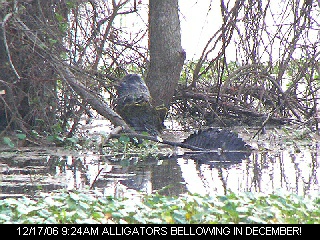 --------
--------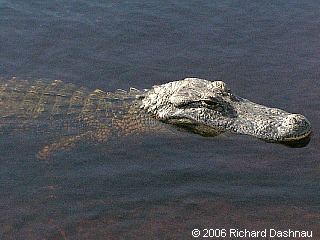
-----WINTER BELLOW---------------
--------COOL GATOR CLOSER
12/03/2006--We've
had
a cold front or two move through our area. The temperature has
dropped
to around 30 degrees for some evenings. Sunday morning, December
3rd, was
pretty chilly. The
sky was clear, with bright sunlight--but the air was
cold. The water was also cold (but not frozen). Even so, I was
able to
see two alligators in 40 Acre Lake as I was heading back to
the
Visitor/Nature
Center. The image above right (COOL GATOR) shows one that was
close to
the shore, but not close to coming out to bask. Look how
clear the
water is! The image below is a
closer view of the same alligator.
I passed
this one, and saw another alligator further out. That one slowly
submerged
and sank. I saw it standing on the bottom as I passed. With the
deep water
so
clear, this was a good illustration of how the alligators deal
with
a cold front coming through. Alligators can hold their
breath for
somewhere around 1 to 6 hours (depending on what you read).
When a cold
front comes through, the air is the coldest environment.
Therefore,
air, and the surfaces contacting the air are the most frigid. This
means
that areas that are not exposed to the air will
be at least a bit
warmer--depending on how long this cold spell lasts. The bottom of
the
lakes will be less frigid than the surface. Alligators will seek
out deeper
water, or dens they've dug, or even
dig into mud to get away from the cold
air.
These
alligators were avoiding the worst cold while lying on the
bottom.
After long invervals of rest, they can come to the surface for
air, and
they can
also test the temperature by exposing their head. An alligator
could also find the amount of radiant heat available on the
exposed surfaces
of its head when the sun shines on it.
March
25, 2007-- I watched an alligator
(about 6
feet long) as it moved near the bank at 40 Acre Lake. It looked
like it
was going to bellow, it even opened its mouth, but then stopped
posturing
and
started leisurely hunting. It was going after schools of very
small
fish that were appearing at the surface. Meanwhile, a larger
alligator
began hunting nearby, and it eventually moved towards the
smaller alligator.
Finally, the smaller gator submerged, probably to hunt a school of
fish
which the larger alligator also noticed. While the smaller was
submerged,
the larger swam at the surface, and
then went for the school (see FISH!
GULP!, below left). There was a slight disturbance, and then the
smaller
gator slowly retreated.
It eventually
walked ashore (see I'M GETTIN' OUTTA HERE, below),
and laid down to bask.
Soon after, the larger alligator also walked onto the bank (see
SAVE ME
A SPOT, below). This was very close to the Observation
Tower.
Somewhere
off in Pilant Slough, an alligator started bellowing. The
larger
alligator returned to the water, moved closer to the tower, and
then began
to bellow. (see WATERDANCE STAGES, below).
I was about 12 feet away. The
battery on my video camera was dead, so no video while I shot the
photos.
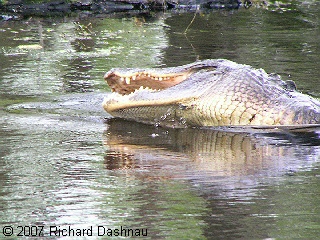 -
-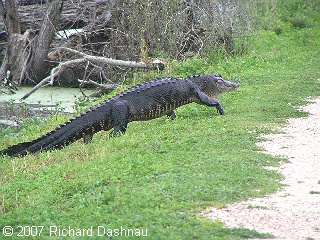 -
-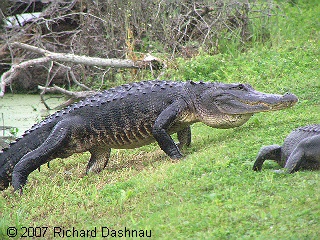
-------
--FISH!
GULP!-
------
---- I'M
GETTIN' OUTTA HERE---
-------SAVE
ME
A SPOT



WATERDANCE
STAGE 1-
---WATERDANCE
STAGE 2--
------WATERDANCE
STAGE 3
08/19/2007---Interesting
sightings...
I hadn't
been at BBSP long. I walked downhill to 40-Acre lake (like I've
been doing
lately), and then stopped to look at the alligator nest on the
first
island.
We had some alligator eggs from another nest in the Visitor's
center, and
they hatched last Friday.
So,
I was looking for evidence that the island nest had hatched. Even
with
my "bare eyes" I could see alligator egg shells scattered on the
island.
I looked through
binoculars,
but couldn't see baby alligators, although I thought I could see
the mother's
head in the water. (see OPENED NEST, and OPENED EGGS, below left)
- -
- -
-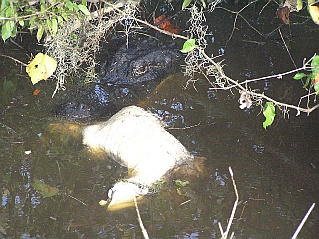 -
-
--OPENED
ALLIGATOR
NEST
OPENED EGGS ON ISLAND
GATOR WITH DEAD
GATOR


HE'S NOTICED ME
HEAD LIFT BEFORE GROWL
Then
I turned, and right behind me, on the other side of the trail, I
saw the
rotted carcass of an alligator--in the jaws of a live alligator.
The live
one was about 10 feet long, the dead one was only a
partial carcass, so
I couldn't guess how big it was. This was in Pilant lake. I walked
past,
and tried to get some pictures. As I did, the alligator reared up
a bit,
and then did a short growl/bellow. Too
bad I wasn't videotaping, but I
did get a couple photos. (see DEAD GATOR, NOTICE ME, HEAD LIFT
above) This
was interesting, because this is just the second time I'd seen an
alligator
growl
near the volume and length of a bellow...as a warning. Just a week
before, I saw it myself for the first time, when an alligator on
the trail
made the same sound when some people passed by. That
noise certainly gets
your attention, and if you hear it, it's certainly a good idea to
back
off.
The
female by the island started bellowing in answer to the male. Then
the
male in front of me spat out his
carcass, and he started bellowing. I videotaped
some of that. The female bellowed a few more times, but I
kept watch
on the male...since it was right next to me--you know, within
walking distance.
I heard other alligators bellowing further away at the same time.
The
big male stopped bellowing, and I tried to swing the camera around
to catch
the female bellowing. Unfortunately, she stopped
as I was focusing
on her.
Then
things quieted down. (see WITH CARCASS, BELLOWS ON ISLAND, below)
-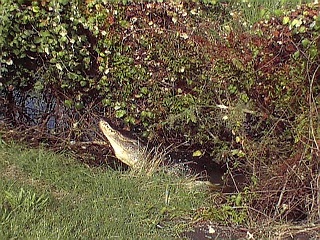 ---
---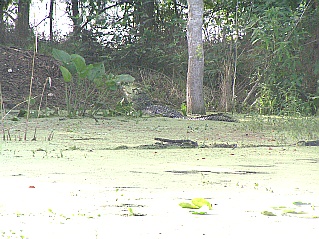 ---
---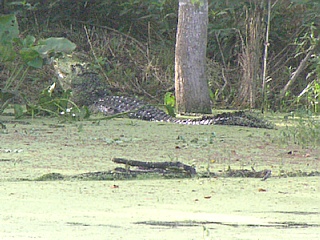 -
-
BELLOW WITH CARCASS
FEMALE BELLOWS ON ISLAND
BELLOWING FEMALE CLOSER
BELLOW
VIDEO wmv 2.6mb
FEMALE
ENDS
BELLOW wmv 5.6mb


NEST WITH
BABIES
THE BABIES
BABIES
ON
THE ISLAND wmv 5.6mb
Then,
in the afternoon, as I was returning, I checked on the nest again,
and
this time I could see the babies through binoculars, but there
were too
many-and
they
weren't clear enough-for me to
count. 15--20? I tried to shoot photos and
a little video (see NEST WITH BABIES, above). In the video clip,
the mother
alligator is near the base of the tree to the right of the
image frame.
And,
this
page shows alligators at the park, on land, near various landmarks
at the park.
Go back to my main alligator
page, Alligators
Go
back to my home page, Welcome
to rickubis.com
Go
back
to the See the
World
page.
 --------
--------















